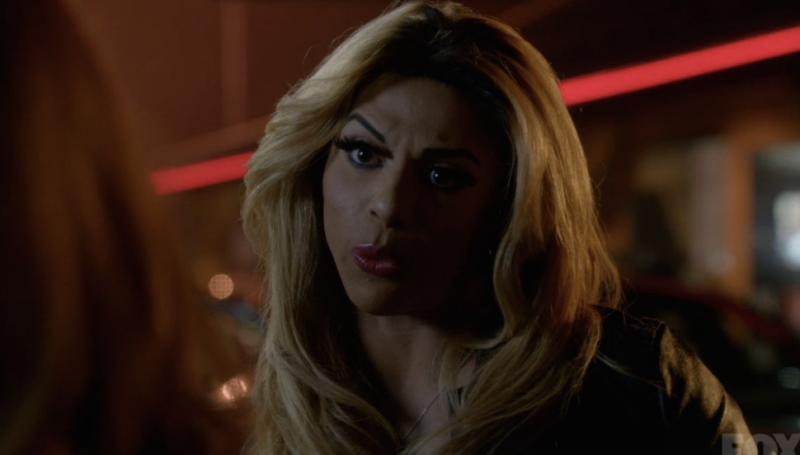Since becoming ensnared in Netflix’s demonic clutches, I’ve embarked on something of a quest to watch all the 1990s television I missed as a child. (Well, not Friends. I’m not that much of a masochist.) Besides Star Trek, my primary focus has been The X-Files, that gloriously weird paranormal investigation show that allowed David Duchovny a chance to play an alcoholic sex addict and Gillian Anderson to completely eclipse his career.
I wasn’t able to get through even the first season before the new mini-series began last month, and I’ve held off on watching it until now. There are so many callbacks and references to episodes I’ve never seen, it’s not nearly as much fun as it should be. But then again, maybe I’m biased. Maybe I don’t find it fun—and maybe never will—because the latest episode, “Mulder and Scully Meet the Were-Monster,” manages to be bizarrely transphobic and tone-deaf well before the 15-minute mark.
The scene in question features D.J. Pierce, almost certainly cast because of his clips as Shangela on RuPaul’s Drag Race. Cis folks, take note: drag queens aren’t implicitly trans women. Many of them, like Pierce, are gay men who enjoy wearing camp femininity as a costume—which is fine. But to cast a drag queen as a trans woman is potentially even worse than casting a vanilla cishet boy. That’s not just because equating a trans woman with a “female impersonator” carries obvious transphobic weight, but because a drag queen is arguably more likely to embrace a harmful stereotypical role, as we saw in this episode.
Pierce plays a trans sex worker named Annabelle who, immediately after being rejected by a john, is accidentally accosted by a were-human in lizard form (long story). Upon questioning from Agents Mulder and Scully, Annabelle quips that the creature wore “tighty-whities, like I used to wear.” Wha-huh? “I transitioned last year,” Annabelle adds casually, in a display of disclosure that no trans woman has ever emulated (especially not to law enforcement of any kind, especially not as a trans woman of color). Later, she admits that she’s on crack cocaine, again, to federal agents.
Before we continue, it’s important to note the context of this episode. Writer/director Darin Morgan, a cis man, is known for penning several of the original X-Files’ more comedic episodes. He’s responsible for writing the episode “Humbug,” which takes Mulder and Scully to a Florida town made up of circus sideshow performers (somewhat offensive in itself). His aim with “Meet the Were-Monster” is much the same as “Humbug”: to flip the script on the show’s classic formula by showing the freakishness inherent in humanity. “Meet the Were-Monster” gives us no end of off-the-wall characters, including an eccentric and pill-popping psychiatrist, a nerdy animal control officer played by Kumail Nanjiani, and the monster itself, played in its human incarnation by Flight of the Conchords’ Rhys Darby. One might argue that Annabelle is simply another wacko and shouldn’t be taken as a serious character.
And you’d be right—but also missing the point. The problem here is that Annabelle, unlike any other character, is based entirely on dated stereotypes that have resulted in a systematic dehumanization of trans people. The cheap motel’s peeping-Tom manager is unlikely to inspire anti-hotel owner violence, and the only other actor of color in the episode (Nanjiani) manages to escape any possible clichés (unless someone has a book of Pakistani animal abuse jokes I somehow missed). Pierce’s character is the only one to be based on real-world prejudices, and the only one who represents a community that is damaged by her presentation. Laughing at the “dumb tranny crack whore” only feeds the kind of hatred that results in cheering after people like Kathy Sal are publicly beaten and hospitalized. (And I’m not even touching the scene in which Darby says she “hit [him] like a man.”)
It’s especially impressive that, in 2016—when we’re ostensibly approaching a golden age of trans visibility—Morgan manages to screw up so badly. In The X-Files’ first season, the 1994 episode “Gender Bender” also obliquely dealt with trans issues, but in a much more interesting (and appropriate) way. At that time, Mulder and Scully pursued a murderer who was able to change genders and induce a pheromone reaction in humans that led to anaphylactic shock. While the subtext is cringe-worthy—trans people trick you into sleeping with them, are inherently dangerous—Larry and Paul Barber’s script is arguably more concerned with the perils of AIDS in general than with trans panic, and at the very least represents the hang-ups of that decade. (What’s more, Mulder and Scully’s heteronormative worldview clouds their judgment in creating a profile of the killer, making the episode vaguely progressive in a roundabout way.) The fact that Morgan somehow managed to be more disrespectful and harmful than his predecessors were over 22 years ago clouds his competency as a creator—and to this new X-Files’ ability to change with times.
—Follow Sam Riedel on Twitter: @SamusMcQueen

